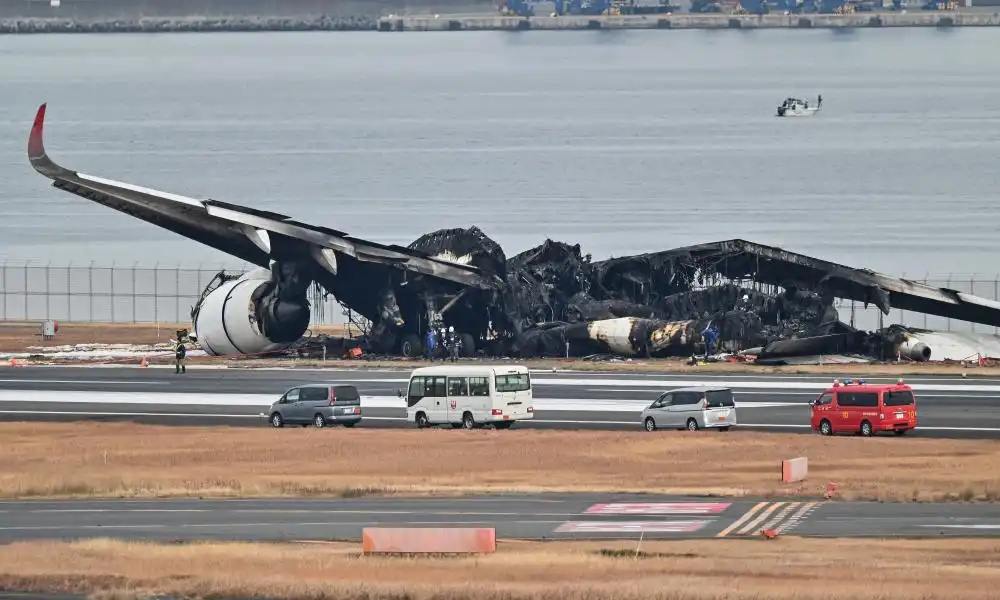Japan plane crash: reasons jet didn't explode on impact - explainer
"Japan Airlines jet crash at Tokyo airport results in miraculous escape for passengers and crew, thanks to low fuel levels."
After all 379 passengers and crew on a Japan Airlines jet that crashed into another plane at a Tokyo airport escaped the burning aircraft, experts have examined how they managed to get out mostly unharmed, and said that low fuel levels likely prevented an explosion.
At about 5:45pm on Tuesday evening, JAL flight 516 - an Airbus A350-900 that departed the northern city of Sapporo about an hour and a half earlier - collided with a coast guard plane when landing at Haneda airport, killing five of the six onboard the smaller Dash 8 aircraft.
The plane was engulfed by fire but critically, didn't explode on impact. Fire did however quickly spread throughout the plane, and it took authorities until 8:30pm, almost three hours after the initial impact, to extinguish the aircraft.
The plane featured carbon fibre composites which burn more easily, but experts downplay the role its materials played, while noting the way in which the A350 burned is a relatively new phenomenon in aviation.
Dr Sonya Brown, a senior lecturer in aerospace design at the University of New South Wales' school of mechanical and manufacturing engineering, said that while the first generation of passenger jets in the 20th century were made largely from metal, aviation engineers have been increasing the proportion of carbon fibre composite materials over time as a way to reduce weight and increase efficiency.
Approximately 50% of the A350 is made from carbon fibre reinforced polymers, which Brown said is among the highest proportion ever produced. Wings, as well as the fuselage, are some of the largest structures on the plane made from the composites. Aluminium, steel and titanium are still relied upon, but to a lesser degree.
"Obviously the materials do impact the fire performance, and while we don't know the specifics of the resins used in the plane in this incident, they will lose their structural capability, their sense of thickness, at a lower temperature than aluminium," Brown said.
Japan Airlines took delivery of the A350 in November 2021, Airbus said in a statement, as it announced it was sending a team of specialists to Japan to assist with investigations of the incident.
Brown said the footage suggested the initial flame was on the aircraft's left wing, and was so significant that a metal body plane would have also caught fire.
"Carbon fibre composites might start to lose some of their stiffness at about 200 degrees, while aluminium will melt at about 700 degrees, but the fire we saw on that fuselage will have had temperatures above 1000 degrees Celsius," she said.
"It will have had some impact on the way it burns because the resins combust at lower temperatures, and while it will change the performance of the fire, the carbon fibre composites weren't going to change the overall outcome of this."
Brown noted the fire was contained in the left wing - likely thanks to firewalls made of materials which become combustible at much higher temperatures to prevent flames spreading to areas such as engines and fuel tanks - long enough for everyone on board to evacuate.
While crews must be trained to evacuate all passengers in 90 seconds, this would have likely taken longer due to the inability to use the doors above the wings.
Once those on board had fled, the intensity of the flames was largely dictated by the what the plane was carrying - and what it wasn't.
"I think we see this with a lot of fires, it takes a very long time to come under control, it's not just the materials of the planes, there's batteries, electrical systems, other luggage and freight which could have anything in them, which could also burn," Brown said.
The relatively low amount of jet fuel the plane was likely carrying at landing could have minimised the intensity of the fire and prevented a potential explosion, Brown said.
Neil Hansford, a industry consultant at Strategic Aviation Solutions, said commercial aircraft tend to operate with just the fuel needed for a trip, plus 10% as a buffer, in order to maximise fuel efficiency.
"It's an industry rule that you always carry the trip fuel, plus 10%, plus enough to take you to the alternate airport you provided in your flight plan, which would have likely been (Tokyo's) Narita in this case," Hansford said.
Hansford said that while a plane's exterior, regardless of its construction materials, would burn out over time in the event of the fire that occurred at Haneda, aircraft interiors are designed to prevent flames spreading for as long as possible to allow for safe evacuation.
"Everything on the interior of the aircraft is designed to mitigate burning, the seats are made of fireblock material," he said.












Comments on Japan plane crash: reasons jet didn't explode on impact - explainer